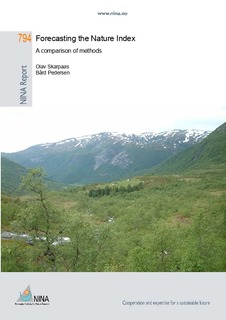| dc.description.abstract | Skarpaas, O. & Pedersen, B. 2012. Forecasting the Nature Index: a comparison of methods -
NINA Report 794. 28 pp.
The Nature Index (NI) is an aggregate of many biodiversity indicators developed to give an overview of the state and trends of biodiversity. The NI is currently also being considered and implemented for other applications such as monitoring of national ecological sustainability and assessments of local management plans. For these and other applications of the NI, methods for forecasting future trends and responses to pressures and management actions are needed. In this report we discuss the opportunities for systematic forecasting of the NI. Our goal is twofold: First, to provide a basis for decisions regarding forecasting of the NI framework in general and, second, to provide specific advice for forecasting the current implementation of the Nature Index for Norway. The report briefly describes the current NI framework and its implementation in Norway and then discusses alternative forecasting methods in relation to the various purposes of forecasting and the properties of the NI with consequences for forecasting. Finally, a selection of methods is tested using simulated data and real data for forest in Norway. Ideally, we need a framework for forecasting that allows non-linear dynamics and covariates (mechanisms) and can handle missing values and short time series. Multivariate analysis may be necessary for certain applications. Automated forecasts may be necessary when there are many time series, and useful for on-the-fly updates and forecasts online. No forecasting method completely satisfies these requirements. For indicators that are known to follow standard population dynamics models, these models may be the best predictive tools. For certain parameter values the Ricker model may be a useful representation of the aggregated NI. The drawback is that these models must be specifically tailored to each case. Of the generic tools, ARIMA seems to be the most promising, as it includes common population dynamics models as special cases and a method to deal with non-stationarity (differencing), the incorporation of pressures is straightforward, modeling dependence among indicators is possible and procedures for automated model selection and forecasting exist. Our tests on simulated time series and data for forest suggest that ARIMA is the best alternative (considering bias and precision) among formal methods when the underlying dynamics are unknown and the time series are sufficiently long. When the underlying dynamics are known, specific dynamic models may perform better. However, for the current low number of data points in time in the NI (4-5), simple naive forecasts perform better than formal methods. When forecasts are made at the NI level, disregarding individual indicators, the best approach seems to be to extrapolate the current state; linear extrapolation of the trend between the two last observations is better when forecasts are made at the level of individual indicators and then aggregated. KEY WORDS Norway, Nature Index, biodiversity, forecasting, ARIMA, forest, Norge, Naturindeks, biologisk mangfold, framskriving, ARIMA, skog | nb_NO |
